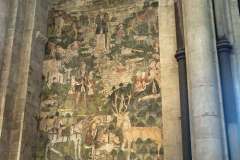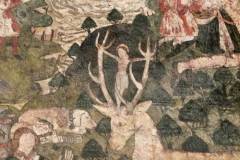This wall painting, dating from around 1480, was uncovered in 1830 when lime wash was removed from the wall of the north aisle of the choir. It shows the story of St Eustace, a legendary Christian martyr who lived in the second century AD. The setting is a series of wooded landscapes with details of ships, hamlets, churches, castles, monkeys, and a river meandering to the sea. The story starts at the bottom, with Eustace on his knees before his quarry, a white stag, between whose horns can be seen an image of Christ. It ends with Eustace and his family roasted to death in a large bull placed over a fire (!)
What to see:
- a very large pre-reformation wall painting covering an entire alcove in the north aisle of the choir – it has the look of a Flemish tapestry (Image 1)
- the projecting stone ledge two thirds up the inside of the alcove wall – this is the ‘springing’ of the arch as originally constructed around 1130 by Prior Ernulf, intended as a window, before the vault was raised in height by William of Sens in 1177
- fascinating details from the legend of the life of Eustace – eg Christ foretells the expected suffering of a convert (Image 2)
- many other vivid scenes – in addition to the roasting of the family in the bull, look out for his wife seized by pirates, a son carried off by a wolf, and a smiling lion carrying off the second son
Source: see standard cathedral sources; also Robertson (1929); Tristram (1951)
DL


